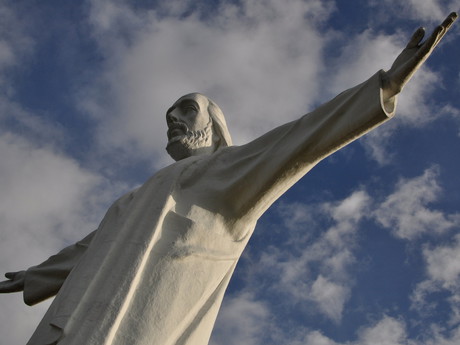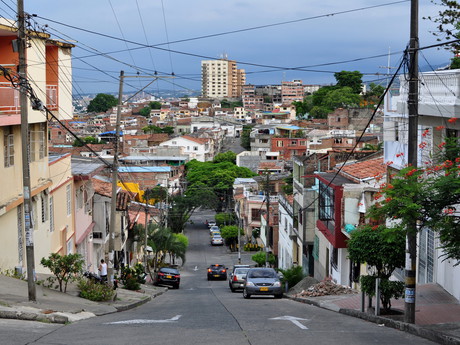Colombia: Cali - city of salsa

Cali is Colombia's third lrgest city which makes it one of the most important economic and industrial centers in the country. Moreover, it is a great city for tourists and to relax. We reach the city center of Cali by hitchhiking. We don't have to look for accomodation for we have this already arranged through couchsurfing. Paola with her friends picks us up and take us a for a ride to Cerro de Los Cristales, a scenic point up in 1 474 meters above the sea level. There is the statue of Jesus – Monumento a Cristo Rey. The monument is 26 meters high, 5 meters of which is the pedestal, teh statue itself is 21 meters tall. Its construction bega in 1949 and was done by sculptor Palmirano G. Navia. It was finished by Alideo Tazzioli three years later.
What we find better than the statue is the vista over the entire city and the mountains. There is a reason why they call Cali the green city. Paola knows her city very well. She describes us individual buildings and their purpose. She also tells us that the poor are hlped here by the volunteers when painting their houses or entire districts. Everything looks better and more colorful after that.
She told us also some myths and history of natives for her grandmotehr was an indian. She tells us about the foundation of three crosses on Cerro de las Tres Cruces. Thge main cross is 26 meteres high. The side crosses 22 meters. Buzarico - the devil - was pretext fo its construction. He was responsible for the sins and diseases troubling the locals. They decided to build three crosses in 1938. Since then the city dwellers are troubled no more. Local climb on foot on the hill to give homage the three crosses every year on May 3rd. The three crosses are one of the main places of the faithful during the Easter.
We stop at indian-themed clay statues on our way. These were made by artists Carlos Andrés Gómez in 2009. He made them alone and named them „Lamento de Pacha Mama“. Nobody helped him. Nobody paid him. This was only his initiative. His works tries to emmanate message that people have bad relationship towards nature and the environment.
San Antonio is another place we visit - a colonnial district with bohemian atmosphere and workshops, antique stores, space for art, culture, and small restaurants with popular colonnial traditions. It is Saturday. We watch a wedding at Capilla de San Antonio chapel. Weddings either take place morning or afternoon over here, and the partying doesn't stops in the morning as it is common in the Czech Republic. This quite surprises us for Colombians as a nationa love to party till the morning. Here, people dance in the park and anybody can join them. Everybody is gone in the evening dancing salsa in local clubs.
Colombians hold Sunday as a day of lunch with their parents .Paola leaves for her family and we alone go to walk around the city. The historic center has many beautiful buildings and is concentrated around Parque Simon Bolívar. There we make a pleasant walk along the Rio Cali. We see the building of Jorge Isaacs theater made in French neoclassical style with renovated facade. Then there is La Ermita, a Gothic church which you can often find on postcards of Cali. The church was founded in 1678. An earthquake destroyed it in 1925. Then it was renoated again between the years 1930 and 1948. Its marble altar made in the 18th century was brought here from Italy, musical clock and windows were made in Amsterodam, and iron gates were made in Cali in 1937. There are over three centuries old paintings inside the church.
White, neoclassical cathedral of San Pedro has survived several earthquakes. Its current facade was renovated for the last time in 1930. The brick compound Complejo Religioso de San Francisco was constructed between teh 18th and 19th centuries. It consists of four parts: San Francisco church, San Joaquín cloister, Virgen Inmaculada church, and a Mudejar-style tower.
Our last day in Cali which is the last day in Colombia is the time when we tested their arepa. It is qite different and filled with a filling - either with meat, somethign sweet, or it is vegetarian. We liked it. So now we are off to Ecuador.
Text and photos: Tomáš Novák
| Discussion at the article (0) |
Related Articles

Colombia, Medellin - the city of spring and Escobar

Panama, Ciudad de Panamá – The City and the Panama Canal

Colombia: Salento - between the mountains

Colombia: Bogota - the capital of the country

Colombia: Tunja, and Villa de Leyva

Colombia: San Gil and Barichara

Colombia: San Juan de Girón

Colombia: ancient Santa Marta

Colombia: Cartagena - a city by the Caribbean Sea

Colombia: from Medellin to Cartagena across Santa Fe
Related Photogallery

Colombia: A Drug Land Turned Tourist Paradise
Guide:
Important Information:
![]() Information and warnings on travelling abroad is to be found HERE.
Information and warnings on travelling abroad is to be found HERE.


































